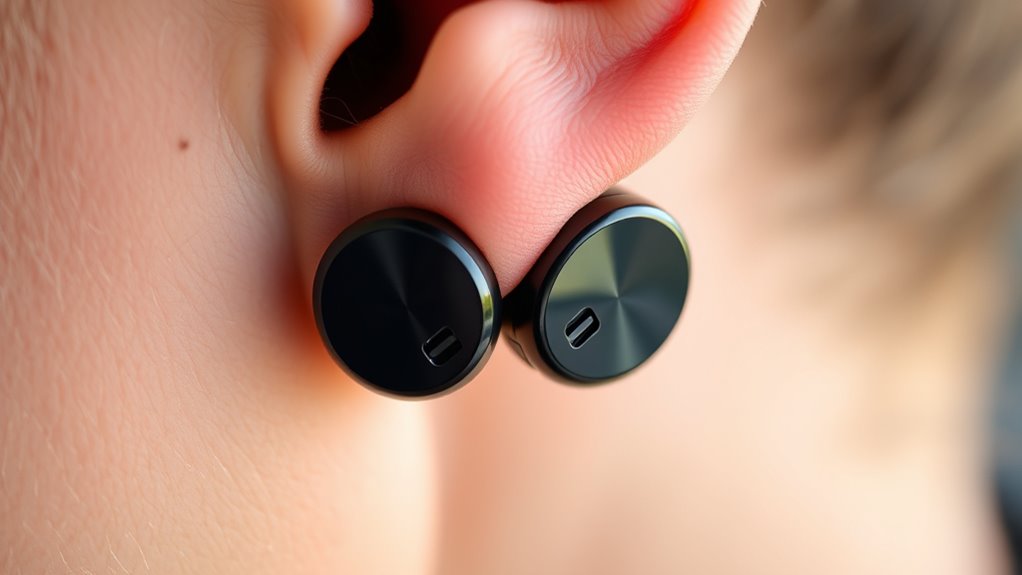Bluetooth earbuds deliver sound wirelessly, but listening at high volumes or for long periods can damage your hearing by overstimulating or killing delicate inner ear hair cells. Poor fit and external noise can cause you to turn up the volume, increasing risks. Using noise-canceling features and taking regular breaks helps protect your ears. Staying aware of symptoms like ringing or muffled sounds is essential. Keep exploring to learn how to enjoy your earbuds safely.
Key Takeaways
- Listening at high volumes with Bluetooth earbuds can overstimulate and damage inner ear hair cells, leading to permanent hearing loss.
- Wireless earbuds’ portability and noise-canceling features may encourage longer, louder listening sessions, increasing hearing risk.
- Proper fit and seal reduce external noise, allowing lower volume levels and protecting ear health.
- Extended use without breaks can cause ear fatigue, ringing, muffled hearing, and other signs of hearing strain.
- Technological advances like real-time monitoring and smart volume regulation aim to minimize hearing damage from Bluetooth earbuds.
Understanding How Bluetooth Earbuds Deliver Sound
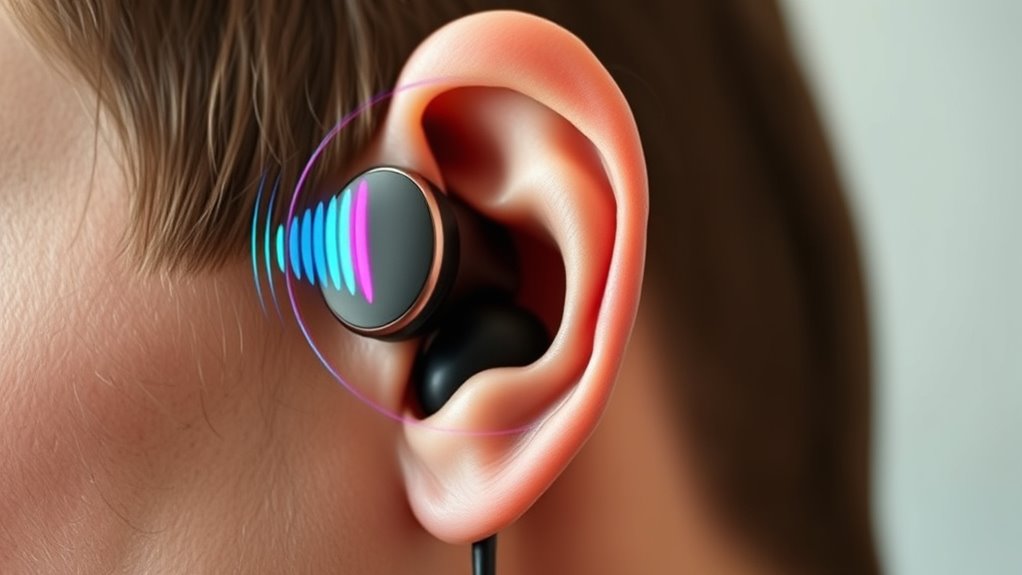
Bluetooth earbuds deliver sound wirelessly by transmitting digital audio signals from your device to the earbuds using radio frequency waves. When you play music or a call, your device encodes the sound into digital data. This data is then sent via Bluetooth—an open wireless technology—through radio frequencies. The earbuds receive this signal and decode it back into audio. Inside, tiny drivers convert the digital signals into sound waves that travel into your ears. This process eliminates the need for wires, offering convenience and mobility. The quality of sound depends on the Bluetooth version, codec support, and the earbuds’ hardware. Understanding this process helps you appreciate how wireless technology delivers audio smoothly, but it also highlights the importance of managing volume and usage to protect your hearing health. Properly managing sound exposure from Bluetooth earbuds is essential to prevent potential hearing damage over time.
The Relationship Between Volume Levels and Hearing Damage
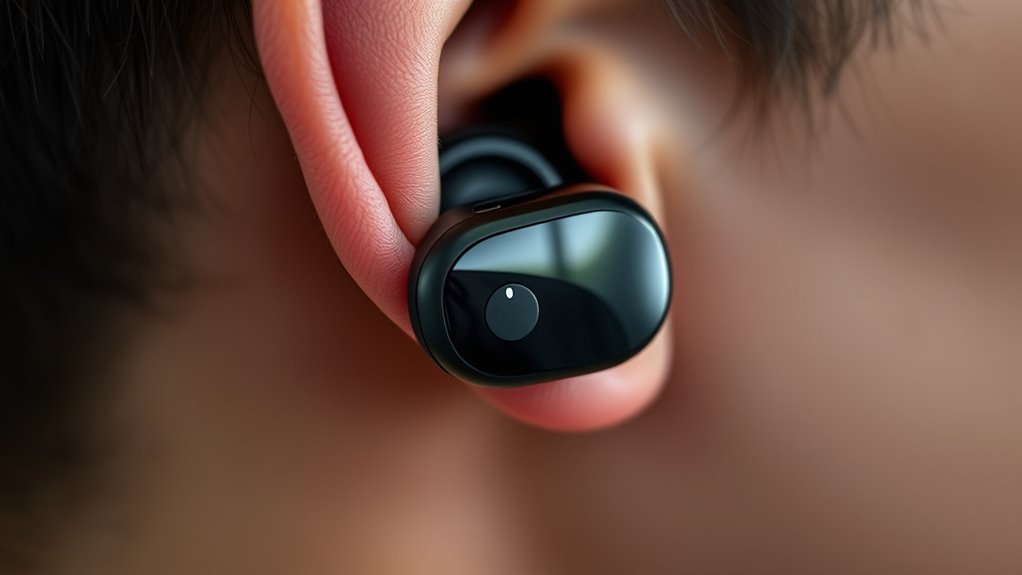
Listening at high volume levels can quickly cause hearing damage, even over short periods. When you turn up your earbuds too loud, your inner ear’s hair cells become overstimulated and can start to die. The louder the sound, the less your ear can protect itself, increasing the risk of permanent damage. Even brief exposure to loud sounds can cause temporary threshold shifts, making your hearing temporarily muffled or distorted. Over time, repeated exposure to high volumes accelerates hair cell loss, leading to permanent hearing loss. It’s essential to keep your volume at a safe level, ideally below 60% of the maximum, and avoid turning it up in noisy environments. Protecting your hearing now helps prevent long-term damage later. Additionally, understanding sound exposure limits can help you better manage your listening habits and safeguard your hearing health.
Risks of Listening at High Volumes for Extended Periods

Prolonged exposure to high volume levels considerably increases the risk of hearing damage. When you listen at loud volumes for extended periods, your ears are subjected to excessive sound energy, which can damage the delicate hair cells in your inner ear. These hair cells are essential for converting sound waves into electrical signals your brain interprets as sound. Once damaged, they don’t regenerate, leading to permanent hearing loss. Continuously exposing yourself to loud music from earbuds accelerates this damage, making hearing problems more likely over time. Additionally, high-volume listening can cause ear fatigue, ringing (tinnitus), and discomfort. To protect your hearing health, keep volumes at a moderate level and limit listening duration, ensuring your ears aren’t overwhelmed by excessive noise. Regular exposure to loud sounds, such as through earbuds, can also contribute to long-term hearing health risks.
The Impact of Earbud Fit and Seal on Hearing Health
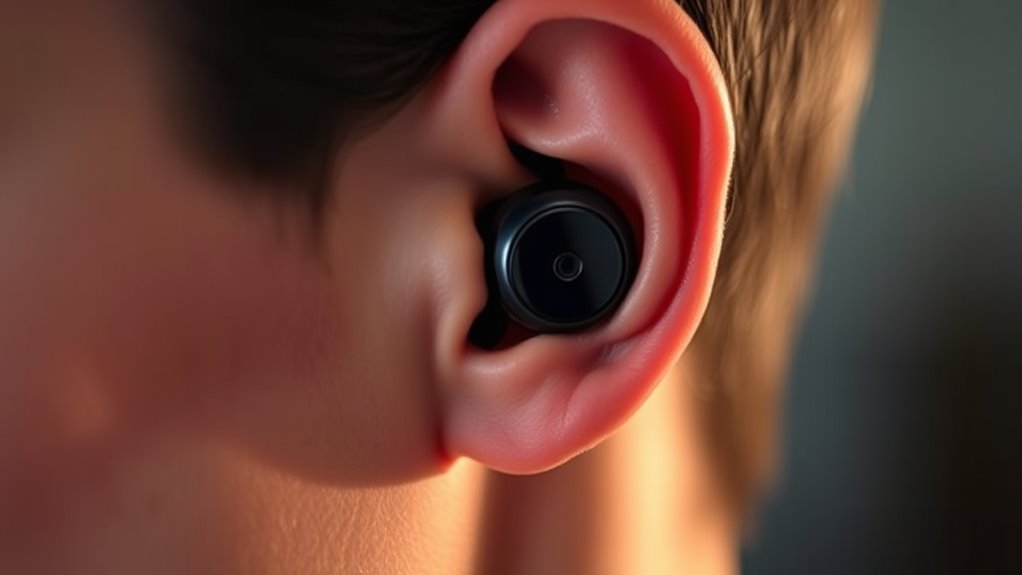
The fit and seal of your earbuds directly influence your hearing health by affecting how sound enters your ears and how much you need to turn up the volume. A proper fit creates a tight seal, reducing external noise and letting you listen at lower volumes. Conversely, a poor fit causes you to increase volume to hear clearly, risking damage over time. When your earbuds fit well, you protect your hearing by avoiding unnecessary volume increases. Ensuring a good fit minimizes strain and helps maintain long-term ear health. Additionally, AI-driven solutions are increasingly being used to analyze and improve earbud design for optimal fit and comfort.
Recognizing Symptoms of Hearing Strain and Fatigue
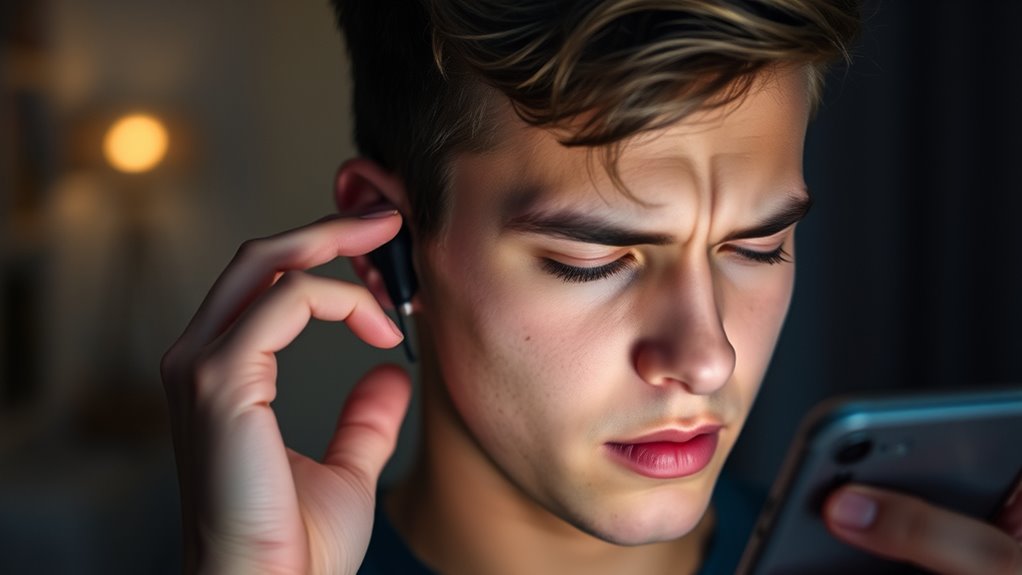
You might notice your ears feel tired or sore after listening for a while. You could also experience ringing, muffled sounds, or difficulty focusing. Recognizing these signs early can help you prevent more serious hearing issues down the line. Additionally, prolonged use of Bluetooth earbuds can lead to hearing fatigue, emphasizing the importance of taking breaks during extended listening sessions.
Signs of Hearing Fatigue
Hearing fatigue often sneaks up on you, making it harder to focus or understand sounds clearly over time. You might notice that your ears feel heavy or tired after listening for a while. You could find yourself asking others to repeat themselves or straining to catch words. You might experience a dull ache or sense of fullness in your ears. Sometimes, your concentration dips, and even simple conversations become challenging. Signs include:
- Difficulty understanding speech in noisy environments
- A feeling of ear fullness or pressure
- Reduced ability to distinguish sounds clearly
- Increased need to turn up volume levels
Recognizing these signs early helps you take steps to protect your hearing health and avoid further strain.
Common Listening Discomfort
Recognizing common listening discomfort is essential to prevent long-term hearing issues. You might notice a feeling of fullness, ringing, or muffled sounds after extended use. Headaches, ear pain, or a sensation of pressure are signs you’re pushing your hearing limits. If you feel tired or find it hard to concentrate, your ears could be strained. Being aware of these symptoms helps you take breaks and protect your hearing health. Here’s a quick guide:
| Symptom | Action to Take |
|---|---|
| Ringing or buzzing | Reduce volume and rest ears |
| Ear pressure or pain | Take a break and lower volume |
| Headache | Limit listening time |
| Muffled hearing | Seek a hearing check |
Additionally, prolonged exposure to high-volume levels can cause noise-induced hearing loss, so it’s important to monitor your listening habits. Listening discomfort signals your ears need relief—don’t ignore them.
The Role of Noise Cancellation in Protecting Hearing
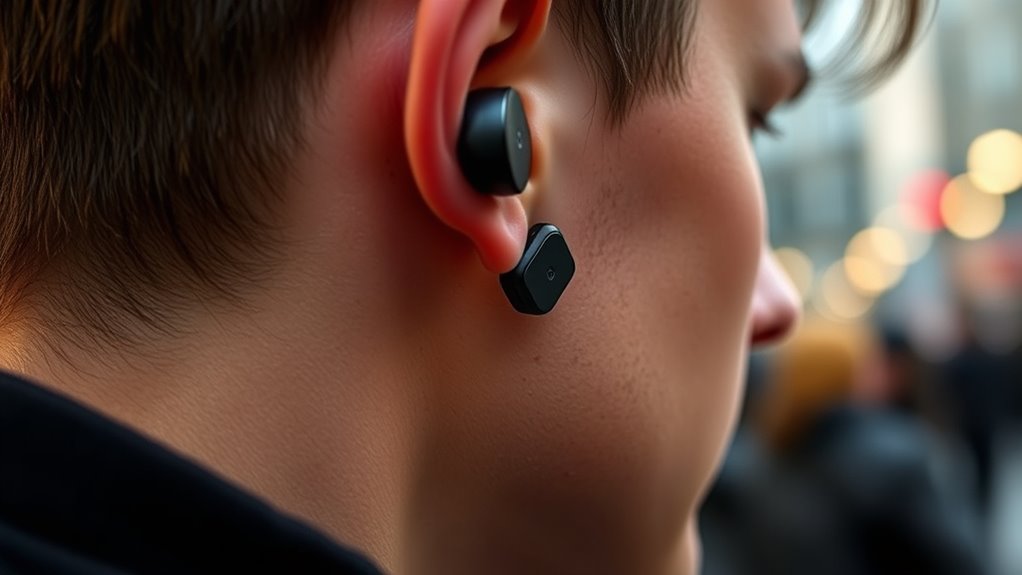
Noise cancellation technology in Bluetooth earbuds plays a crucial role in protecting your hearing by reducing the need to listen at high volumes. By blocking out ambient sounds, these features let you enjoy audio clearly without turning up the volume excessively. This minimizes the risk of damaging your ears over time. Imagine:
- Hearing conversations clearly without raising your voice
- Listening comfortably in noisy environments like cafes or public transit
- Avoiding the urge to increase volume due to background noise
- Protecting your ears from potential damage caused by loud, prolonged exposure
- Understanding how city dynamics influence listening habits and safety
With effective noise cancellation, you can maintain safer listening levels, reducing strain on your ears. This technology empowers you to enjoy music and calls without risking your hearing health, making your listening experience safer and more comfortable.
Differences Between Wired and Wireless Earbud Effects
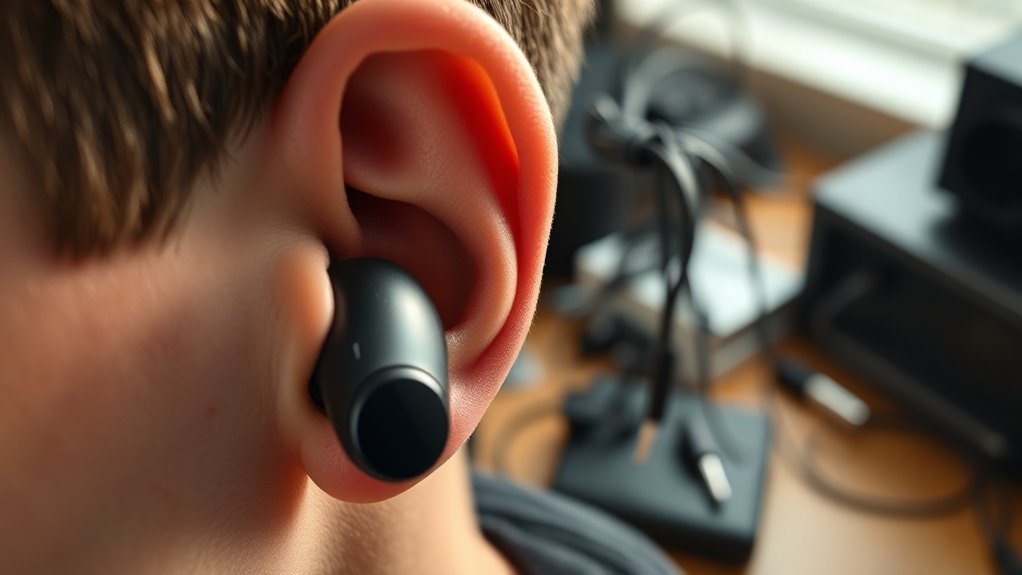
While both wired and wireless earbuds deliver audio, their effects on your hearing health can differ considerably. Wired earbuds typically fit snugly into your ears, which can help you control volume and duration more easily. However, they may exert more pressure, increasing discomfort if used improperly. Wireless earbuds often sit loosely or in the ear canal, making it easier to listen at higher volumes without realizing it. Their portability encourages longer use, potentially exposing you to noise levels that harm your hearing. Additionally, some wireless models feature active noise cancellation, which might tempt you to increase volume to block out external sounds. Ultimately, how each type affects your hearing depends on your listening habits, volume levels, and duration of use. Being mindful of these differences can help protect your hearing health and reduce the risk of noise-induced hearing loss.
Safe Listening Habits for Long-Term Hearing Preservation
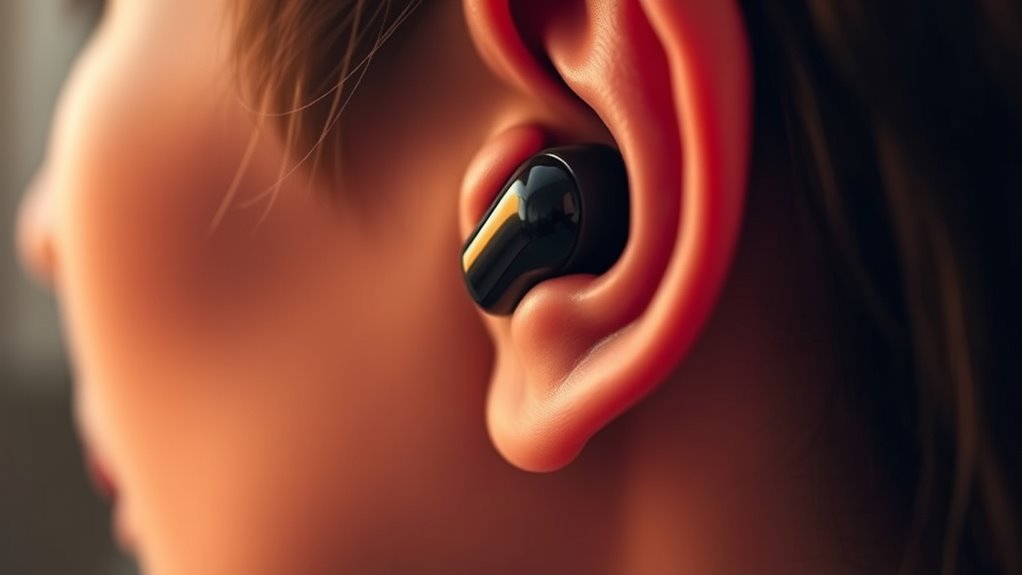
To protect your hearing over time, it’s important to keep your listening sessions short and avoid cranking up the volume. Using noise-canceling features can help you enjoy better sound quality at lower volumes. Remember, practicing these habits now can preserve your hearing for years to come. Incorporating special occasions into your routine, such as taking breaks and adjusting volume levels during extended listening, can further safeguard your hearing health.
Limit Listening Duration
Limiting the amount of time you spend listening to your Bluetooth earbuds is essential for protecting your hearing. Extended exposure increases the risk of damage, even at moderate volumes. To promote safe listening habits, consider these tips:
- Take breaks every 60 minutes to give your ears a rest.
- Set a timer to remind you when to pause listening.
- Reduce overall daily listening time to under two hours.
- Be mindful of how long you’ve been using earbuds, especially during long commutes or workouts.
- Staying informed about hearing health risks associated with prolonged headphone use can help you make safer choices.
Maintain Moderate Volume Levels
Maintaining moderate volume levels is essential for safeguarding your hearing over the long term. When you listen at high volumes, your ears endure increased pressure, which can damage delicate hair cells in your inner ear. To protect your hearing, keep the volume below 60% of your device’s maximum. If others can hear your earbuds, your volume is likely too high. Be mindful of your listening environment; noisy surroundings often tempt you to crank up the volume. Regularly checking and adjusting your volume settings helps prevent unintentional overexposure. Remember, even brief periods of high-volume listening can cause irreversible damage. By staying conscious of your volume levels, you markedly reduce the risk of hearing loss and preserve your auditory health for years to come.
Use Noise-Canceling Features
Using noise-canceling features can substantially reduce the need to turn up your earbuds’ volume in noisy environments. When you activate noise reduction, background sounds are minimized, allowing you to listen at lower volumes without missing details. This helps protect your hearing over time. To maximize safety, consider:
- Using noise-canceling mode in busy places like transit or streets
- Lowering volume since less external noise requires less loudness
- Combining noise cancellation with awareness of your surroundings
- Regularly updating your earbuds’ firmware for ideal performance
Emerging Technologies Aiming to Reduce Hearing Risks
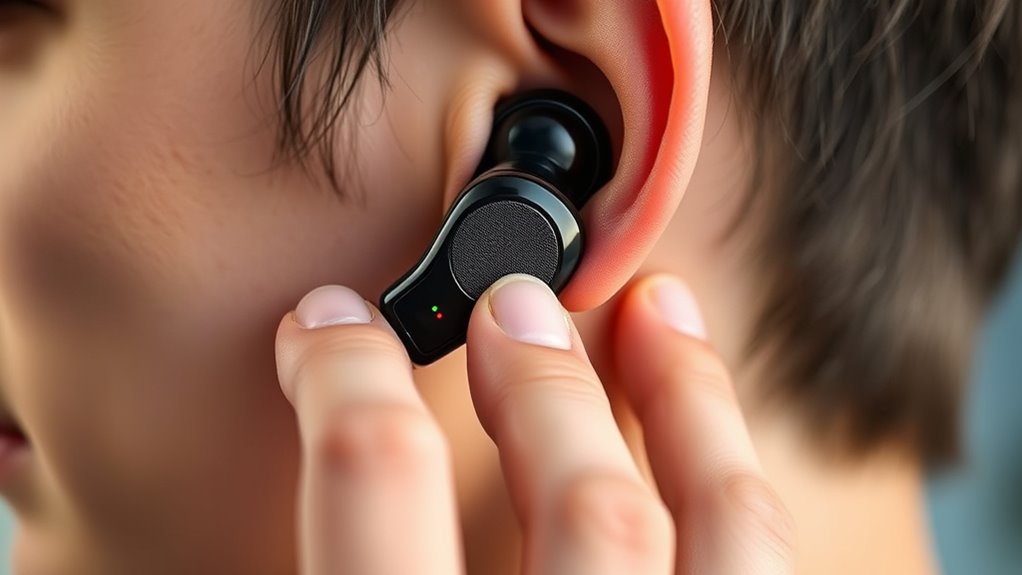
As technology advances, innovative solutions are emerging to help reduce the hearing risks associated with Bluetooth earbuds. One promising development is smart volume regulation that automatically adjusts sound levels based on your environment, preventing you from listening at dangerously high volumes. Another innovation involves real-time monitoring, where earbuds track your listening habits and alert you if you’re using them excessively or at unsafe volumes. Some companies are exploring adaptive sound technology that filters out harmful noise frequencies, reducing the need to crank up volume. Additionally, there are earbuds equipped with health sensors that monitor ear health and provide feedback to minimize damage. These emerging technologies aim to make listening safer without sacrificing convenience or sound quality, helping you enjoy your audio while protecting your hearing.
Tips for Maintaining Good Hearing Health While Using Earbuds
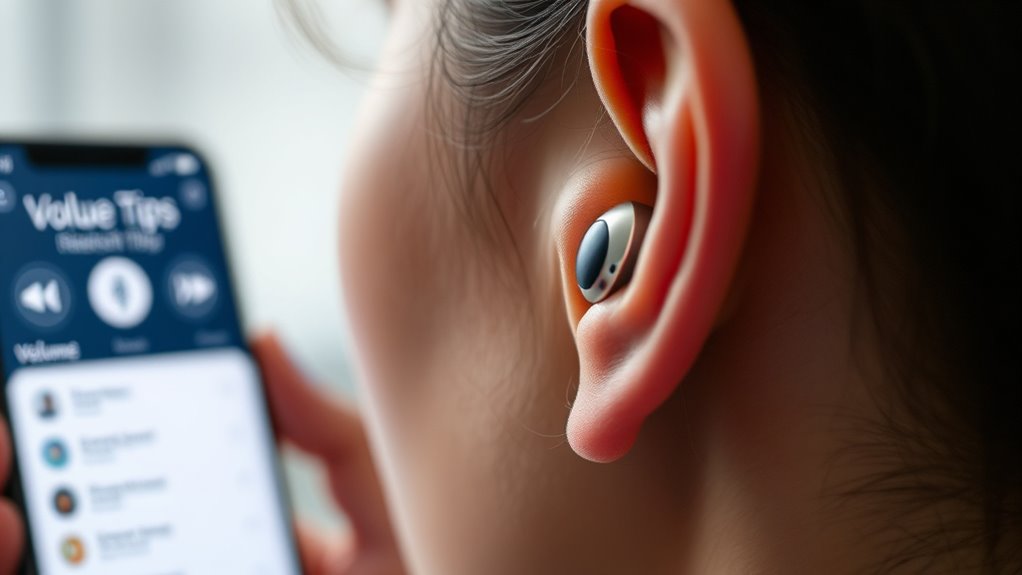
To protect your hearing while using earbuds, it’s important to manage your volume and listening time. Keep the volume at a safe level and limit how long you listen each day. These simple strategies can help prevent hearing damage and keep your ears healthy.
Volume Control Strategies
Controlling the volume on your earbuds is essential for protecting your hearing health. Keeping the volume at a moderate level reduces the risk of damage over time. To help, consider these strategies:
- Set a maximum volume limit on your device.
- Use volume-limiting earbuds designed for safe listening.
- Adjust the volume before putting the earbuds in your ears.
- Be mindful of your environment; avoid turning up the volume in noisy settings.
Safe Listening Duration
Listening to your earbuds for extended periods can still pose a risk to your hearing health, even if the volume is moderate. To protect your ears, limit your listening sessions to no more than 60 minutes at a time. Take at least a 5-minute break afterward to give your ears a rest. Avoid listening at high volumes for long durations, as this can cause damage over time. Pay attention to how your ears feel; if you notice ringing or discomfort, it’s time to stop. Using apps that track your listening time can help you stay within safe limits. Remember, consistent moderation is key to maintaining good hearing health while enjoying your earbuds.
Frequently Asked Questions
Can Bluetooth Earbuds Cause Long-Term Hearing Loss?
You might wonder if Bluetooth earbuds can cause long-term hearing loss. While they emit low-level radiation and deliver loud sounds, the risk depends on how loud and how long you listen. If you keep the volume at safe levels and limit usage, you reduce the chance of damage. Prolonged exposure to loud music from any device, including Bluetooth earbuds, can harm your hearing over time. So, be mindful of volume and duration.
Are There Specific Brands With Safer Bluetooth Earbud Designs?
A picture is worth a thousand words, and when choosing Bluetooth earbuds, safety is key. Some brands, like Sony and Bose, prioritize ergonomic designs and noise-canceling features that reduce the need for high volume. Look for models with volume limiters and good audio quality. You’re better off choosing reputable brands known for safety and comfort, helping you enjoy your music without risking your hearing health.
How Do Bluetooth Earbud Radiation Levels Compare to Other Devices?
You might wonder how Bluetooth earbuds’ radiation compares to other devices. They emit low levels of radiofrequency radiation, similar to cell phones and Wi-Fi devices. While these levels are generally within safety limits set by health authorities, prolonged close contact can still raise concerns. To minimize exposure, use earbuds at lower volumes and take breaks. Being informed helps you make smarter choices for your hearing health.
Do Bluetooth Earbuds Impact Ear Canal Health Over Time?
Have you ever wondered if wearing Bluetooth earbuds long-term impacts your ear canal health? Over time, prolonged use can cause irritation, wax buildup, or even infections if you don’t keep them clean and dry. It’s essential to listen at safe volumes and take breaks. Are you prioritizing your ear health? Regular cleaning, proper fit, and moderation help protect your ears from potential problems caused by continuous use.
What Legal Regulations Exist for Bluetooth Earbud Safety Standards?
You might wonder what rules guarantee Bluetooth earbuds are safe. Currently, regulations vary by country; many follow standards set by organizations like the FCC or CE, which limit radiation exposure and enforce safety testing. Some regions have specific guidelines for wireless device emissions and sound levels. Staying informed helps you choose compliant earbuds that meet safety standards, reducing potential health risks and ensuring you’re protected while enjoying wireless convenience.
Conclusion
By being mindful of volume, duration, and fit, you can enjoy your Bluetooth earbuds without risking your hearing. Remember, your ears are yours for life—so why not protect them now? Staying informed about safe listening habits and embracing new tech can make a big difference. Are you ready to prioritize your hearing health and keep enjoying your favorite sounds for years to come?
